Documents: Go to download!
User Manual
- User Manual - (English)
- Daily Reference Guide - (English)
- NEL data sheet - (English)
- Energy Label - (English)
- Product information sheet - (English)
- Healthy safety&enviromental - (English)
- Installation
- Care and maintenance
- Description of the washer-dryer
- How to run a wash cycle or a drying cycle
- Detergents and laundry
- Troubleshooting
Table of contents
User Manual
Installation
Unpacking and levelling
Unpacking

This is a separate part of the polystyrene base and should be removed with the base.
IMPORTANT check when unpacking your machine.

- Unpack the washerdryer.
- Check whether the washer-dryer has been damaged during transport. If this is the case, do not install it and contact your retailer.
- Remove the 4 protective screws and the rubber bush with the respective spacer, situated on the rear of the appliance (see also the installation leaflet).
- Seal the gaps using the plastic plugs provided.
- Keep all the parts: you will need them again if the washer-dryer needs to be moved to another location.
- Packaging materials are not children’s toys
Levelling
Your machine may make a considerable amount of noise if the two front feet have not been adjusted correctly

1. Install the washer dryer on a flat sturdy floor, without resting it up against walls, cabinets or anything else.
2. If the floor is not perfectly level, compensate for any unevenness by tightening or loosening the adjustable front feet (see figure); the angle of inclination, measured according to the worktop, must not exceed 2°.
Levelling your appliance correctly will provide it with stability and avoid any vibrations, noise and shifting during operation. If it is placed on a fitted or loose carpet, adjust the feet in such a way as to allow enough room for ventilation beneath the washer-dryer.
Electric and water connections
Connecting the water inlet hose
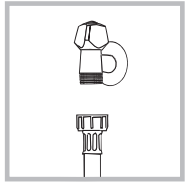
1. Connect the supply pipe by screwing it to a cold water tap using a 3/4 gas threaded connection (see figure). Before performing the connection, allow the water to run freely until it is perfectly clear

2. Connect the other end of the water inlet hose to the washerdryer, screwing it onto the appliance’s cold water inlet, situated on the top right-hand side on the rear of the appliance (see figure).
3. Make sure there are no kinks or bends in the hose.
Connecting the drain hose

Connect the drain hose, without bending it, to a draining duct or a wall drain situated between 65 and 100 cm from the floor;

The drain hose may be connected to an under-sink trap. Before connecting the drain hose from the machine ensure that any blanks or removable ends have been taken off the spigot.

If it is placed over the edge of a basin or sink be sure the free end of the hose should not be underwater.
- We advise against the use of hose extensions; in case of absolute need, the extension must have the same diameter as the original hose and must not exceed 150 cm in length. Ensure that if the drain hose is pushed into a standpipe, that the end does not go down more than 15cms (6 inches). If the hose is pushed down too far, this may cause the machine to self -syphon ie. continuously empty as it is filling.
Electric connection
Before plugging the appliance into the mains socket, make sure that:
- the socket is earthed and in compliance with the applicable law;
- the socket is able to sustain the appliance’s maximum power load indicated on the Technical Data Plate fixed on the machine;
- the supply voltage is included within the values indicated on the Technical Data Plate fixed on the machine.
- the socket is compatible with the washerd ryer’s plug. If this is not the case, replace the socket or the plug.
Your appliance is now supplied with a 13 amp fused plug it can be plugged into a 13 amp socket for immediate use. Before using the appliance please read the instructions below.
WARNING - THIS APPLIANCE MUST BE EARTHED.
THE FOLLOWING OPERATIONS SHOULD BE CARRIED OUT BY A QUALIFIED ELECTRI- CIAN.
Replacing the fuse:
When replacing a faulty fuse, a 13 amp ASTA approved fuse to BS 1362 should always be used, and the fuse cover re-fitted. If the fuse cover is lost, the plug must not be used until a replacement is obtained.
Replacement fuse covers:
If a replacement fuse cover is fitted, it must be of the correct colour as indicated by the coloured marking or the colour that is embossed in words on the base of the plug. Replacements can be obtained directly from your nearest
Service Depot.
Removing the plug:
If your appliance has a non-rewireable moulded plug and you should wish to re-route the mains cable through partitions, units etc., please ensure that either: the plug is replaced by a fused 13 ampere rewireable plug bearing the BSI mark of approval.
or:
the mains cable is wired directly into a 13 amp cable outlet, controlled by a switch, (in compliance with BS 5733) which is accessible without moving the appliance.
Disposing of the plug:
Ensure that before disposing of the plug itself, you make the pins unusable so that it cannot be accidentally inserted into a socket.
Instructions for connecting cable to an alternati- ve plug:
Important: the wires in the mains lead are coloured in accordance with the following code:

As the colours of the wires in the lead may not correspond with the coloured markings identifying the terminals in your plug, proceed as follows:
Connect Green & Yellow wire to terminal marked E or  or coloured Green or Green & Yellow.
or coloured Green or Green & Yellow.
Connect Brown wire to terminal marked L or coloured Red.
Connect Blue wire to terminal marked N or coloured Black.
If a 13 amp plug (BS 1363) is used it must be fitted with a 13 amp fuse, either in the plug or adaptor or at the distribution board.
If you are in any doubt regarding the electrical supply to your machine, consult a qualified electrician before use.
How to connect an alternative plug:
The wires in this mains lead are coloured in accordance with the following code:
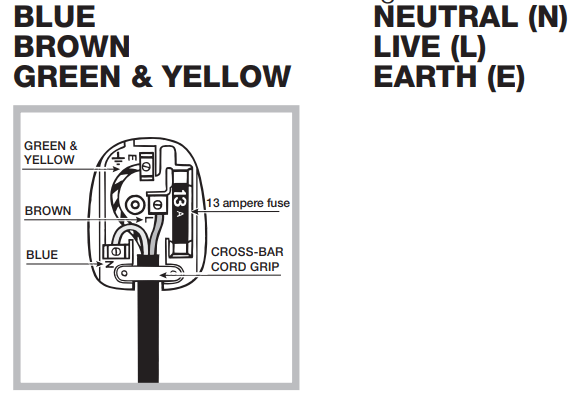
Disposing of the appliance:
When disposing of the appliance please re- move the plug by cutting the mains cable as close as possible to the plug body and dispo- se of it as described on the previous page.
The first wash cycle
Once the appliance has been installed, and before you use it for the first time, run a wash cycle with detergent and no laundry, using wash cycle number auto clean (see “Cleaning the washer-dryer”).
Care and maintenance
Cutting off the water and electri- city supplies
- Turn off the water tap after every wash cycle. This will limit wear on the hydraulic system inside the washer-dryer and help to prevent leaks.
- Unplug the washer-dryer when cleaning it and during all maintenance work.
Cleaning the washer-dryer
- The outer parts and rubber components of the appliance can be cleaned using a soft cloth soaked in lukewarm soapy water. Do not use solvents or abrasives.
- The washer-dryer has a auto clean programme for its internal parts that must be run with no load in the drum.
To help the wash cycle you may want to use either the detergent (i.e. a quantity 10% the quantity specified for lightly-soiled garments) or special additives to clean the washer-dryer. We recommend running a cleaning program- me every 40 wash cycles.
To activate the programme, press the  button for 5 seconds then press START/PAUSE to start the programme, which will last roughly minutes.
button for 5 seconds then press START/PAUSE to start the programme, which will last roughly minutes.
Cleaning the detergent dispenser drawer
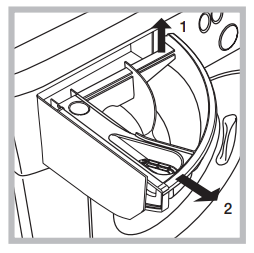
Remove the dispen- ser by raising it and pulling it out (see figure). Wash it under running water; this operation should be repeated frequently.
Caring for the door and drum of your appliance
- Always leave the porthole door ajar in order to prevent unpleasant odours from forming.
Cleaning the pump
The washer-dryer is fitted with a self-cleaning pump which does not require any maintenance. Sometimes, small items (such as coins or buttons) may fall into the pre-chamber which protects the pump, situated in its bottom part.
- Make sure the wash cycle has finished and unplug the appliance.
To access the pre-chamber:
1. using a screwdri- ver, remove the cover panel on the lower front part of the washer-dryer (see figure)
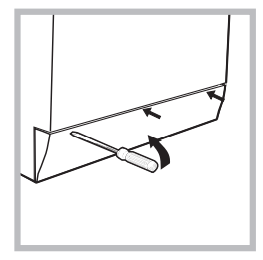
2. unscrew the lid by rotating it anticlockwise (see figure): a little water may trickle out. This is perfectly normal;
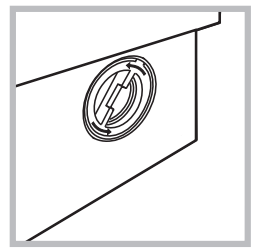
3. clean the inside thoroughly;
4. screw the lid back on;
5. reposition the panel, making sure the hooks are securely in place before you push it onto the appliance.
Checking the water inlet hose
Check the inlet hose at least once a year. If there are any cracks, it should be replaced immediately: during the wash cycles, water pressure is very strong and a cracked hose could easily split open.
Description of the washer-dryer

Detergent dispenser drawer: used to dispense detergents and washing additives (see “Detergents and laundry”).
Programme Key: the Programme Key inside the detergent dispenser shows all the available programmes together with a graphical guide on how to use the individual dispenser compartments.
ON/OFF button  : press this briefly to switch the machine on or off. The START/PAUSE indicator light, which flashes slowly in a green colour shows that the machine is switched on. To switch off the washer-dryer during the wash cycle, press and hold the button for approximately 3 seconds; if the button is pressed briefly or accidentally the machine will not switch off. If the machine is switched off during a wash cycle, this wash cycle will be cancelled.
: press this briefly to switch the machine on or off. The START/PAUSE indicator light, which flashes slowly in a green colour shows that the machine is switched on. To switch off the washer-dryer during the wash cycle, press and hold the button for approximately 3 seconds; if the button is pressed briefly or accidentally the machine will not switch off. If the machine is switched off during a wash cycle, this wash cycle will be cancelled.
WASH CYCLE SELECTOR KNOB: used to set the desired wash cycle (see “Table of programmes and wash cycles”).
FUNCTION button: press the button to select the desired function. The corresponding indicator light on the display will switch on.
AUTO CLEAN button: press to clean the machine’s internal parts (see “Cleaning the washer-dryer”).
DIRECT INJECTION button: press to select the DIRECT INJECTION option.
MULTI RINSE button  : press to select the desired rinse type.
: press to select the desired rinse type.
SPIN button  : press to reduce or completely exclude the spin cycle - the value is indicated on the display.
: press to reduce or completely exclude the spin cycle - the value is indicated on the display.
TEMPERATURE button  : press to decrease the temperature: the value will be shown on the display.
: press to decrease the temperature: the value will be shown on the display.
DRYING button  : press to decrease or exclude drying; the selected drying level or time will appear on the display.
: press to decrease or exclude drying; the selected drying level or time will appear on the display.
DRY ONLY (DRYING ONLY) button : press to run the drying cycle only.
: press to run the drying cycle only.
KEY LOCK button  : to activate the control panel lock, press and hold the button for approximately 2 seconds. When the display visualises “KEY LOCK ON” the control panel is locked (apart from the ON/OFF button). This means it is possible to prevent wash cycles from being modified accidentally, especially where there are children in the home. To deactivate the control panel lock, press and hold the button for approximately 2 seconds.
: to activate the control panel lock, press and hold the button for approximately 2 seconds. When the display visualises “KEY LOCK ON” the control panel is locked (apart from the ON/OFF button). This means it is possible to prevent wash cycles from being modified accidentally, especially where there are children in the home. To deactivate the control panel lock, press and hold the button for approximately 2 seconds.
DELAY button  : press to set a delayed start time for the selected wash cycle. The delay time will be shown on the display.
: press to set a delayed start time for the selected wash cycle. The delay time will be shown on the display.
START/PAUSE button with indicator light: when the green indicator light flashes slowly, press the button to start a wash cycle. Once the cycle has started the indicator light will remain lit in a fixed manner. To pause the wash cycle, press the button again; the indicator light will flash in an orange colour. If the symbol  is not illuminated, the door may be opened. To start the wash cycle from the point at which it was interrupted, press the button again.
is not illuminated, the door may be opened. To start the wash cycle from the point at which it was interrupted, press the button again.
Standby mode
This washer-dryer, in compliance with new energy saving regulations, is fitted with an automatic standby system which is enabled after about 30 minutes if no activity is detected. Press the ON-OFF button briefly and wait for the machine to start up again.
Consumption in off-mode: 0,5 W
Consumption in Left-on: 8 W
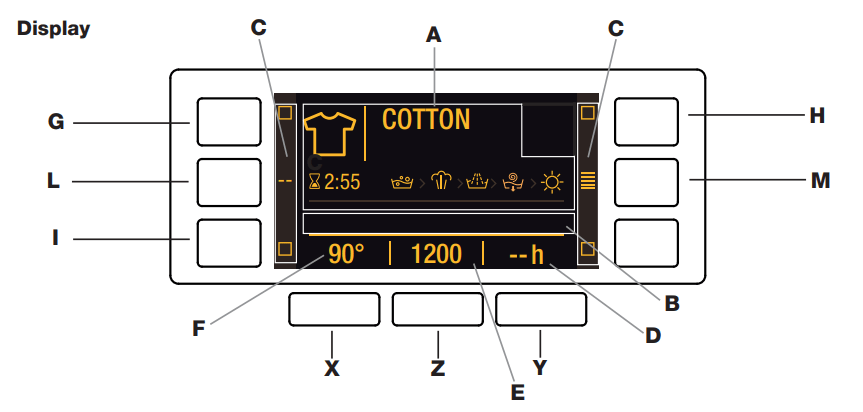
The display is useful when programming the machine and provides a great deal of information.
The following will appear in area A: the icon and programme selected, the washing and drying phases and time remaining to the end of the cycle.
Area B will include the two intensity levels relative to the DIRECT INJECTION option.
The indicator lights relative to the available functions appear in area C.
Area D will have the time remaining to the start of the selected programme if the DELAY function was set.
String E shows the maximum spin speed value (this depends on the selected wash cycle); if the programme does not include the spin cycle, the dimly lit “--” symbol will appear in the area.
Area F will visualise the temperature value selectable on the basis of the set programme; if the temperature of the programme cannot be set, the area will show the symbol “--” dimly lit.
Door locked symbol
If the symbol is lit, this indicates that the washer-dryer door is blocked to prevent it from being opened accidentally. To prevent any damage from occurring, wait for the symbol to switch itself off before opening the appliance door.
N.B.: if the DELAY function has been activated, the door cannot be opened; pauses the machine by pressing the START PAUSE button if you wish to open it.
- The first time the machine is switched on, you will be asked to select the language and the display will automatically show the language selection menu.
To select the desired language press the X and Y buttons; to confirm the selection press the Z button.
To change the language switch off the machine and press buttons G, H, I simultaneously until an alarm is heard: the language-selection menu will be displayed again.
- To change the display luminosity, which by default is set to the highest value, switch the machine off then simultaneously press buttons G, L and M until the buzzer sounds. Press buttons X and Y to choose the desired level of luminosity then confirm by pressing button Z.
- During the wash cycle or when the DELAY function has been enabled, if the user does not interact with the display for 1 minute the “SCREEN SAVER” activates. To return to the previous window, simply press any button.
How to run a wash cycle or a drying cycle
1. SWITCH THE MACHINE ON. Press the On/Off button ; the text HOTPOINT will appear on the display and the START/ PAUSE indicator light will flash slowly in a green colour.
2. LOAD THE LAUNDRY. Open the porthole door. Load the laundry, making sure you do not exceed the maximum load value indicated in the table of programmes on the following page.
3. MEASURE OUT THE DETERGENT. Open the detergent dispenser drawer and pour the detergent into the relevant compartments as described in “Detergents and laundry”.
4. CLOSE THE DOOR.
5. SELECT THE WASH CYCLE. Use the WASH CYCLE SELECTOR knob to select the desired wash cycle; the name of the wash cycle will appear on the display. A temperature and spin speed is set for each wash cycle; these may be adjusted. The duration of the cycle will appear on the display.
6. CUSTOMISE THE WASH CYCLE. Use the relevant buttons:
Modifying the temperature and/or spin speed. The machine automatically selects the maximum temperature and spin speed set for the selected wash cycle; these values cannot therefore be increased. The temperature can be decreased by pressing the  button, until the cold wash (the display will visualise the “--” symbol) setting is reached. The spin speed may be progressively reduced by pressing the
button, until the cold wash (the display will visualise the “--” symbol) setting is reached. The spin speed may be progressively reduced by pressing the button, until it is completely excluded (the display will visualise the “--” symbol). If these buttons are pressed again, the maximum values are restored.
button, until it is completely excluded (the display will visualise the “--” symbol). If these buttons are pressed again, the maximum values are restored.
! Exception: if the 5 programme is selected, the temperature can be increased up to a value of 40°C.
! Exception: if the 7 programme is selected, the temperature can be increased up to a value of 90°C.
! Exception: if the 9 programme is selected, the temperature can be increased up to a value of 60°C.
Setting a delayed start.
To set a delayed start for the selected programme, press the corresponding button repeatedly until the required delay period has been reached. To remove the delayed start function press the button until the text “-- h” appears on the display.
Setting the drying cycle.
The desired drying cycle type may be set by pressing the DRYING button once or several times. Two options are available:
once or several times. Two options are available:
A - Based on the how damp the clothes are once they have been dried:
Iron: suitable for clothes which will need ironing afterwards. the remaining dampness softens creases, making them easier to remove.
Hanger: ideal for clothes which do not need to be dried fully.
Cupboard: suitable for laundry which can be put back in a cupboard without being ironed.
Extra: suitable for garments which need to be dried completely, such as sponges and bathrobes.
B - Based on a set time period: between 30 and 180 minutes. To exclude the drying phase press the relevant button until the text OFF appears on the display.
If your laundry load to be washed and dried is much greater than the maximum stated load, perform the wash cycle, and when the cycle is complete, divide the garments into groups and put some of them back in the drum. At this point, follow the instructions provided for a “Dry only” cycle. Repeat this procedure for the remainder of the load. A cooling-down period is always added to the end of each drying cycle.
Dry only
Press button  to perform the drying-only cycle. After selecting the desired cycle (compatible with the type of garments), press button
to perform the drying-only cycle. After selecting the desired cycle (compatible with the type of garments), press button to exclude the washing phase and start the drying phase at the maximum level for the selected cycle. The drying level or time may be set and changed by pressing the drying button
to exclude the washing phase and start the drying phase at the maximum level for the selected cycle. The drying level or time may be set and changed by pressing the drying button  . (Not compatible with cycles 1-2-3-4 and 14).
. (Not compatible with cycles 1-2-3-4 and 14).
Set the rinse type.
Option  makes it possible to select the desired rinse type for sensitive skin. Press the button once for the “Extra +1” level, which makes it possible to select an additional rinse after the standard cycle rinse and remove all traces of detergent. Press the button again for the “Extra +2” level, which makes it possible to select two additional rinses to the standard cycle rinses; it is recommended for very sensitive skin. When the button is pressed for the third time, the “Extra +3” level is set, thus allowing the selection of 3 rinses in addition to the standard cycle’s rinses. The option - started with cycles at a temperature of 40°C - makes it possible to remove major allergens such as pollen, cat and dog hair. With cycles at a temperature higher than 40° a very good level of antiallergic protection is achieved. Press the button again to go back to the “Normal rinse” rinse type. If the current adjustment can be neither set nor changed, the display will show “No Selection” or “No Change”.
makes it possible to select the desired rinse type for sensitive skin. Press the button once for the “Extra +1” level, which makes it possible to select an additional rinse after the standard cycle rinse and remove all traces of detergent. Press the button again for the “Extra +2” level, which makes it possible to select two additional rinses to the standard cycle rinses; it is recommended for very sensitive skin. When the button is pressed for the third time, the “Extra +3” level is set, thus allowing the selection of 3 rinses in addition to the standard cycle’s rinses. The option - started with cycles at a temperature of 40°C - makes it possible to remove major allergens such as pollen, cat and dog hair. With cycles at a temperature higher than 40° a very good level of antiallergic protection is achieved. Press the button again to go back to the “Normal rinse” rinse type. If the current adjustment can be neither set nor changed, the display will show “No Selection” or “No Change”.
Modifying the cycle settings.
- Press the button to enable the function; the relevant indicator light on the display will light up.
- Press the button again to disable the function; the relevant indicator light on the display will switch off.
! If the selected function is incompatible with the set programme, the relevant indicator light will appear dimly lit; in addition, the incompatibility will be signalled by a buzzer (3 beeps) and the wording “No Selection” will appear on the display.
! If the selected function is incompatible with another previously set function, the wording “No Selection” will appear on the display and the function will not be enabled.
! The functions may affect the recommended load value and/or the duration of the cycle.
7. START THE PROGRAMME. Press the START/PAUSE button. The corresponding indicator light will become green, remaining lit in a fixed manner, and the door will be locked (the DOOR LOCKED symbol will be on). During the wash cycle, the name of the phase in progress will appear on the display. To change a wash cycle while it is in progress, pause the washer-dryer using the START/PAUSE button (the START/PAUSE indicator light will flash slowly in an orange colour); then select the desired cycle and press the START/PAUSE button again. To open the door while a cycle is in progress, press the START/PAUSE button; if the DOOR LOCKED symbol
will be on). During the wash cycle, the name of the phase in progress will appear on the display. To change a wash cycle while it is in progress, pause the washer-dryer using the START/PAUSE button (the START/PAUSE indicator light will flash slowly in an orange colour); then select the desired cycle and press the START/PAUSE button again. To open the door while a cycle is in progress, press the START/PAUSE button; if the DOOR LOCKED symbol is switched off the door may be opened. Press the START/PAUSE button again to restart the wash cycle from the point at which it was interrupted.
is switched off the door may be opened. Press the START/PAUSE button again to restart the wash cycle from the point at which it was interrupted.
8. THE END OF THE WASH CYCLE. This will be indicated by the text “CYCLE END” on the display; when the DOOR LOCKED symbol  switches off the door may be opened. Open the door, unload the laundry and switch off the machine.
switches off the door may be opened. Open the door, unload the laundry and switch off the machine.
! If you wish to cancel a cycle which has already begun, press and hold the  button. The cycle will be stopped and the machine will switch off.
button. The cycle will be stopped and the machine will switch off.
Direct Injection
The washer-dryer is equipped with the innovative technology «Direct Injection» which pre-mixes water and detergent, thus immediately activating the detergent’s cleaning principles. This active emulsion is directly introduced into the drum of the washer-dryer and penetrates the fibres with more efficacy in cleaning even heavily soiled garments at low temperatures, fully preserving colours and fabrics. The mode «Power» ensures the best cleaning performance and the mode «EcoEnergy» allows more energy saving
Detergents and laundry
Detergent dispenser drawer
Good washing results also depend on the correct dose of detergent: adding too much detergent will not necessarily result in a more efficient wash, and may in fact cause a build up on the inside of your appliance and contribute to environmental pollution.
! Use powder detergent for white cotton garments, for prewashing, and for washing at temperatures over 60°C.
! Follow the instructions given on the detergent packaging.
! Do not use hand washing detergents because these create too much foam.
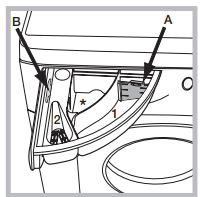
Open the detergent dispenser drawer and pour in the detergent or washing additive, as follows.
! Do not pour detergent into the middle compartment (*). compartment 1: Detergent for the wash cycle (powder or liquid) If liquid detergent is used, it is recommended that the removable plastic partition A (supplied) be used for proper dosage. If powder detergent is used, place the partition into slot B. compartment 2: Additives (fabric softeners, etc.) The fabric softener should not overflow the grid
Preparing the laundry
- Divide the laundry according to: - the type of fabric/the symbol on the label - the colours: separate coloured garments from whites.
- Empty all garment pockets and check the buttons.
- Do not exceed the listed values, which refer to the weight of the laundry when dry: see “Table of wash cycles”.
How much does your laundry weigh?
1 sheet 400-500 g
1 pillow case 150-200 g
1 tablecloth 400-500 g
1 bathrobe 900-1200 g
1 towel 150-250 g
Special wash cycles
Daily Wash & Dry use programme 1 to wash and dry mixed garments (cotton and synthetics). This cycle may be used to wash and dry loads of up to 3 kg; we recommend the use of liquid detergent.
The use of the steam in this programme is optimised to reduce the formation of creases on garments, making them easier to iron.
Shirts Wash & Dry: use programme 2 to wash and dry shirts and T-shirts in different fabrics and colours to ensure maximum care. This cycle may be used to wash and dry loads of up to 2 kg. To achieve optimum results, use liquid detergent and pre-treat cuffs, collars and stains. The use of the steam in this programme is optimised to reduce the formation of creases on garments, making them easier to iron.
Pre Iron: use this programme immediately before ironing; max. 1.5 kg load. The use of the steam in this programme is optimised to reduce the formation of creases on garments, making them easier to iron.
Steam Refresh: for refreshing garments, neutralised unpleasant odours and relaxing the fibres by delivering steam into the drum. The garments will be damp at the end of the cycle.
Anti-Stain Turbo 45’: this cycle ensures excellent stain removal capacity even at 20°C in just 45 minutes. The temperature of this cycle can be increased up to 40°C.
Anti-Stain Power 20°C: this programme ensures maximum stain removal capacity with no need for pre-treatment at low temperatures, preserving fabrics and colours.
Multicolour: for washing coloured cotton garments. This programme is optimised to keep colours bright even after repeated washing.
Ultradelicates: use programme 11 to wash very delicate garments having strasses or sequins.
We recommend turning the garments inside out before washing and placing small items into the special bag for washing delicates. Use liquid detergent on delicate garments for best results.
When selecting an exclusively time-based drying function, a drying cycle is performed at the end of the wash cycle that is particularly delicate, thanks to light handling and appropriate temperature control of the water jet.
The recommended durations are:
1 kg of synthetic garments --> 165 min
1 kg of synthetic and cotton garments --> 180 min
1 kg of cotton garments --> 180 min
The degree of dryness depends on the load and fabric composition
Wool - Woolmark Apparel Care - Green: the wool wash cycle of this machine has been approved by The Woolmark Company for the washing of wool garments labelled as “hand wash” provided that the products are washed according to the instructions on the garment label and those issued by the manufacturer of this washer-dryer.

Sport: for washing lightly soiled sports clothing (tracksuits, shorts, towels, etc.); for best results, we recommend not exceeding the maximum load indicated in the “Table of wash cycles”. We recommend using liquid detergent, and adding the amount suitable for a half-load.
Load balancing system
Before every spin cycle, to avoid excessive vibrations and to distribute the load in a uniform manner, the drum rotates continuously at a speed which is slightly greater than the washing rotation speed. If, after several attempts, the load is not balanced correctly, the machine spins at a reduced spin speed. If the load is excessively unbalanced, the washerdryer performs the distribution process instead of spinning. To encourage improved load distribution and balance, we recommend small and large garments are mixed in the load.
Troubleshooting
Your washer-dryer could occasionally fail to work. Before contacting the Technical Assistance Service (see “ Product Guarantee and Repair Information”), make sure that the problem cannot be solved easily using the following list.
| Problem: | Possible causes / Solutions: |
| The machine does not switch on. |
|
| The wash cycle does not start. |
|
| The machine does not dry |
|
| The clothes are too hot when the drying cycle is finished. | A cooling-down period is always added to the end of each drying cycle. If the clothes appear too hot to handle leave the door open to allow to cool further before removing from the machine. |
| The washer-dryer does not take in water (the text “NO WATER, Turn tap on” appears on the display). |
|
| The machine continuously fills with water and continually drains away or Water left in the drum or Stuck on wash. |
|
| The machine does not drain or spin - (error lights flashing). |
|
| The machine does spin. | The Spin Speed is set to “--”. |
| The machine does not heat or poor wash results. | The ‘Temperature’ is set to “--” |
| The programme takes too long. | Programme times will vary due to water pressure, the incoming water temperature and if the wash load goes out of balance. This will increase the programme times accordingly (see ‘ The machine wont spin properly’ next page) |
| The Display sticks at one ‘time to end’ for more than 1 Minute or the Display changes the estimated ‘Time to End’ during the programme. | The display time is for guidance only - it is not a precise time to finish and may vary. |
| The machine vibrates a lot during the spin cycle. |
|
| The machine is noisy | There will always be some motor, pump and drum noise during spin |
| The machine wont spin properly. | Out of Balance detected when attempting to go into a spin cycle - If this happens the machine will continue to try to repeat the distribution of the load required before the machine will go into higher spin speeds - This will increase the programme time accordingly. This is a safety feature to prevent damage. Out of Balance can be caused by washing a single heavy item (eg duvet, quilt, etc). - Try the programme again using a different load. |
| The machine leaks from the dispenser. |
|
| The machine leaks (other than dispenser). |
|
| The machine is locked and the display flashes, indicating an error code (e.g. F-01, F-..). | Switch off the machine and unplug it, wait for approximately 1 minute and then switch back on again. If the problem persists contact Technical Assistance Centre. |
| The machine smells. | The machine requires a service wash. Run a auto clean wash cycle with detergent and no laundry |
| The machine door cannot be opened. |
|
| Door Seal damaged at the bottom. | The door seal has drainage holes at the bottom - This is normal. |
| The water level is too low when the machine is washing | The water level is correct if it can be seen at the bottom of the door. |
| There is too much foam. |
|
| The machine just ‘beeps’ when a programme or option is selected (Key Lock led is lit). | Deactivate the Key Lock feature by pressing and holding in the ‘KEY LOCK’ button for 2 seconds. |
| After completing the programme, or before starting a programme, the machine has turned itself off (no lights). | To comply with new energy saving regulations the machine is fitted with an automatic standby system. Press ‘ON/OFF’ button for 3 seconds to activate the machine, it can then either be switched off or a new programme selected. |
| General. | Your washer-dryer contains sensors that monitor progress during the wash cycle (eg: Water Levels, Temperatures, Out of Balance loads, Wash time/progress). Normally, if your machine successfully completes the cycle, there is unlikely to be anything wrong! |
Remember, you will be charged for a service call for problems caused by incorrect installation, as indicated on pages 2 to 4. Not emptying contents from pockets may cause pump or drain blockages, or may damage the machine. Do not wash items which do not have a wash label, or wash items that are not intended as machine washable.
See other models: H8 A1E S SA2 540 H WH H7T 911T MX H DD2 844 C BL DD 642 W/H(BK)
